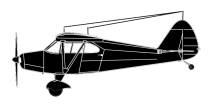
ASN Wikibase Occurrence # 296922
This information is added by users of ASN. Neither ASN nor the Flight Safety Foundation are responsible for the completeness or correctness of this information.
If you feel this information is incomplete or incorrect, you can submit corrected information.
| Date: | Sunday 21 July 2002 |
| Time: | 14:20 LT |
| Type: |  Piper PA-20 |
| Owner/operator: | Private |
| Registration: | N1592A |
| MSN: | 20-829 |
| Total airframe hrs: | 2258 hours |
| Engine model: | Lycoming O-290-D2 |
| Fatalities: | Fatalities: 0 / Occupants: 2 |
| Aircraft damage: | Substantial |
| Category: | Accident |
| Location: | Oshkosh, Wisconsin -
 United States of America United States of America
|
| Phase: | Unknown |
| Nature: | Private |
| Departure airport: | Mount Pleasant Municipal Airport, MI (KMOP) |
| Oshkosh-Wittman Field, WI (OSH/KOSH) | |
| Investigating agency: | NTSB |
| Confidence Rating: |
The PA-20 collided with the runway following an abrupt maneuver to avoid another airplane. The accident occurred during EAA AirVenture 2002, at Oshkosh, Wisconsin. The PA-20 pilot was cleared to land on the "orange dot" (1,500 from the threshold) on runway 27. A Cessna 172 was cleared to land on the numbers of runway 27. The PA-20 pilot reported that during his landing flare, he saw the Cessna 172 underneath his airplane. He pulled up and to the right to avoid a collision with the other Cessna 172. He stated he added full throttle and leveled the nose, but a strong wind from the left rolled the airplane to the left and "without enough airspeed for effective aileron" he could not reverse the roll. The airplane stalled and spun into the runway from an altitude of about 120 feet. The pilot of the Cessna 172 reported that there was a fairly strong left crosswind and that his airplane floated a little on the runway before touching down. Neither pilot reported seeing the other. The Cessna 172 pilot reported that he was unaware that an accident had occurred. Winds at the time of the accident were from 230 degrees at 12 knots gusting to 22 knots. As announced on the airport terminal information service (ATIS), the VFR Oshkosh Arrival, Yellow Flow procedures were in effect at the time of the accident. The Yellow Flow instructs pilots to join the other traffic over over a VFR checkpoint. The traffic then travels around the northwest side of the airport, entering a right base leg for either runway 18L or 18R. In addition to landing VFR traffic on runway 18L and 18R, air traffic control (ATC) was landing VFR traffic on runway 27. This was accomplished by having the VFR traffic extend their base leg for the 18 runways, putting them on a right downwind for runway 27. The VFR landings on runway 27 were not outlined as part of the Yellow Flow procedures. The only landings on runway 27 that are a part of the procedure were IFR arrivals approaching the airport from the east and warbirds who were to approach the airport from the southeast. Neither airplane was issued go-around procedures from ATC. The PA-20 pilot reported that his passenger recalled hearing an ATC transmission about an airplane underneath them, but by this time he had already pulled up and it was too late.
T
Probable Cause: Inadequate visual lookout by both the accident pilot and the pilot of the other airplane. An additional cause is the arrival procedure used which resulted in a congested traffic pattern and the subsequent inadequate visual separation of the airplanes. Factors associated with the accident are the gusty crosswind, the pilot of the other aircraft landed longer than ATC expected, and the stall/spin encountered during the pilot's attempted remedial action.
Accident investigation:
 |
|
Sources:
NTSB CHI02FA200
Revision history:
| Date/time | Contributor | Updates |
|---|---|---|
| 14-Oct-2022 12:23 | ASN Update Bot | Added |
Corrections or additions? ... Edit this accident description
The Aviation Safety Network is an exclusive service provided by:


 ©2024 Flight Safety Foundation
©2024 Flight Safety Foundation